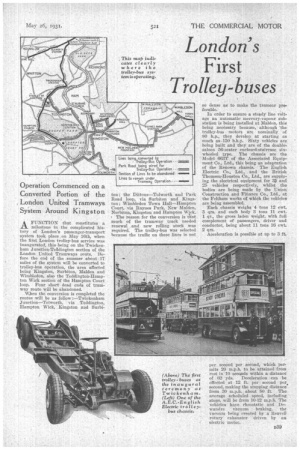London's First Trolley-buses
Page 57

If you've noticed an error in this article please click here to report it so we can fix it.
AFUNCTION that constitutes a milestone in the complicated history of London's passenger-transport system took place on May 16th, when the first London trolley-bus service was inaugurated, this being on the Twickenham Junction-Teddington section of the London United Tramways route. Before the end of the slimmer about 17 miles of the system will be converted to trolley-bus operation, the area affected being Kingston, Surbiton, Malden and Wimbledon, also the Teddingten-Hampton Wick section of the Hampton Court loop. Four short dead ends of tram:Way route will be abandoned.
When the conversion is completed the routes will be as follow :—Twickenham annetkin—Tolworth, via Teddington, Hampton Wick, .Kingston and Surbi ton; the Dittons—Tolworth and Park Road loop, via Surbiton and Kings. ton Wimbledon Town Hall---Hampton Court, via Raynes Park, New Afalde.n, Norbiton, Kingston and Hampton Wick. The reason for the conversion is that much of the tramway track needed renewal and new rolling stock was required. The trolley-bus Was selected because the traffic on these litres is not so dense as to make the tramcar preferable.
In order to ensure a steady line voltage an automatic mercury-vapour substation is being installed at Malden, this being necessary because, although the trolley-bus motors are nominally of 80 h.p., they develop at starting as much as .150 b.h.p. Sixty vehicles are being built and they are of the doublesaloon 56-seater enclosed-staircase sixwheeled type. The chassis are the Model 4363T of the Associated Equipment Co., Ltd., this being an adaptation of the Renown chassis. The English Electric Co., Ltd., and the British Thomson-Houston Co., Ltd., are supplying the electrical equipment for 3; and 2 vehicles respectively, whilst the bodies are being made by the Union Construction and Finance Co., Ltd., at the Feltham works of which the vehicles are being assembled.
Each chassis weighs 4 tons 12 cwt.
3 qrs. and each body 3 tons 11 cwt.
1 qr., the gross laden weight, with full complement of passengers, driver and conductor, being about 11 tons 10 cwt.
2 qrs.
Acceleration is possible at up to 3 ft.
per second per seeond, which per. mits 20 m.p.h. to he attained from rest in 10 secoAds within a distance
of 62 yds. Deceleration can be effected at 12 ft. per second. per second, making the stopping distance from .20 m.p.h. about 80 ft. The average scheduled speed, including steps, will be from 10-12 m.p.h. The vehieles have rheostatic and De,warn-lre vacuum braking, the vacuum being created by a Reeve]] retark exhauster driven by an electric motor.




































































































